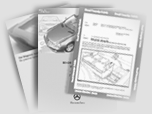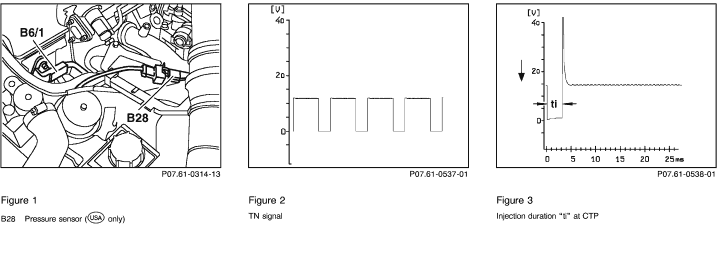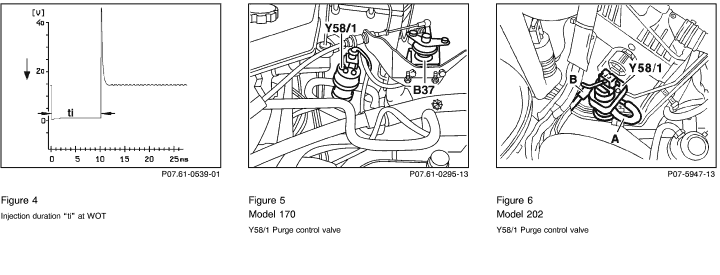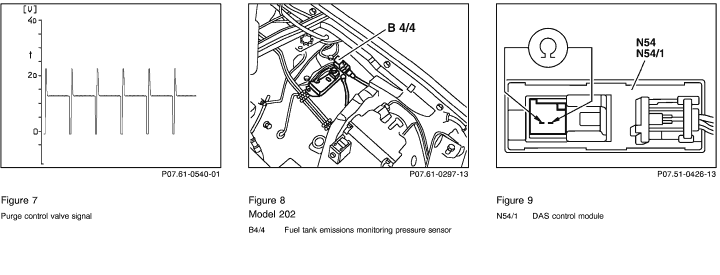 |
 |
Test scope |
Test connection |
Test condition |
Nominal value |
Possible cause/remedy |
| 1.0 |
P 0 5 6 0 |
Engine control module
(ME-SFI) (N3/10)
Voltage supply
Circuit 30 |
3 
(3A) |
N3/10

 |
 12
(4B)
|
Ignition: ON
|
11 - 14 V
|
 1.1 - 1.2 1.1 - 1.2
|
| 1.1 |
|
Ground wire |
3 
(3A)
7 
(7A)
112 
(8F)
119 
(15F)
|
|
X11/4
 2
X11/4
 2
X11/4
 2
X11/4
 2
|
Ignition: ON |
11 - 14 V |
Wiring,
Model 170 and 202:
Output ground (W16/6), right component compartment.
|
| 1.2 |
|
Voltage supply
Circuit 30 |
X11/4
1  |
N3/10

 |
 12
(4B) |
Ignition: ON |
11 - 14 V |
Wiring,
Model 170:
Relay module (K40).
Model 202:
Passenger-side fuse and relay module box (K40/4).
|
| 2.0 |
P 0 5 6 0
|
Engine control module
(ME-SFI) (N3/10)
Voltage supply
Circuit 87
|
8 
(8a) |
N3/10

 |
 2
(2A)
|
Ignition: ON |
11 - 14 V |
 2.1 - 2.2 2.1 - 2.2 |
| 2.1 |
|
Electronics ground |
8 
(8a) |
N3/10

 |
X11/4
 2 |
Ignition: ON |
11 - 14 V |
Wiring,
Model 170 and 202:
Output ground (W16/6), right component compartment.
|
| 2.2 |
|
Voltage supply
Circuit 87 |
X11/4
1  |
N3/10

 |
 2
(2A) |
Ignition: ON
Ignition: OFF |
11 - 14 V
< 1 V
|
Wiring,
Model 170:
Relay module (K40).
Model 202:
Passenger-side fuse and relay module box (K40/4).
|
| 3.0 |
P 1 1 8 2 |
Starter lock-out relay module (N65k2) or K40k2
Model 170, 202 as of 06/97
Activation
|
35 
(3D) |
N3/10

 |
 2
(2A)
|
Engine coolant
temperature >20°C
Ignition/starter switch:
Turn to starter contact briefly. |
11 - 14 V
or if engine does not start, for approx. 5 seconds |
 3.1 3.1
Engine control module (N3/10) |
| 3.1 |
|
Starter signal
Circuit 50 |
8 
(8a) |
N3/10

 |
 32
(40C)
|
Motor: Start
|
11 - 14 V,
while cranking. |
Wiring,
Ignition switch. |
| 4.0 |
P 0 1 0 0 |
Hot film MAF
sensor (B2/5)
Hot film signal
|
104 
(48E) |
N3/10

 |
 103
(47E) |
Ignition: ON
Engine: at Idle
Engine coolant
temperature >70°C
|
0.9 - 1.1 V
1.3 - 1.7 V
Increasing rpm = increasing voltage. |
Wiring,
 4.1 - 4.3 4.1 - 4.3
Air intake system leak,
B2/5.
|
| 4.1 |
|
Hot film MAF sensor (B2/5)
Voltage supply 5 V |
N3/10

104 
(48E) |
|
B2/5
 4
|
Disconnect MAF sensor (B2/5) connector and measure directly on socket 4 (br/yl).
Ignition: ON
|
4.7 - 5.2 V |
Wiring,
N3/10 |
| 4.2 |
|
Ground wire for hot film MAF sensor (B2/5) |
B2/5
3 
|
|
N3/10

 102
(46E) |
Disconnect MAF sensor (B2/5) connector and measure directly on socket 3 (br).
Ignition: ON
|
4.7 - 5.2 V |
Wiring. |
| 4.3 |
|
Hot film MAF sensor (B2/5)
Voltage supply 12 V |
N3/10

104 
(48E) |
|
B2/5
 2
(2)
|
Disconnect MAF sensor (B2/5) connector and connect plus of voltmeter to socket 2 (rd/bu).
Ignition: ON |
11 - 14 V |
Wiring,
Model 170:
Relay module (K40)
Model 202:
Passenger-side fuse and relay module box (K40/4).
|
| 5.0 |
P 0 1 1 0 |
IAT sensor in hot film MAF sensor (B2/5)
Voltage |
104 
(48E) |
N3/10

 |
 101
(45E) |
Ignition: ON |
oC V
10 3.1
20 2.7
30 2.2
40 1.8
50 1.4
60 1.1
± 5%
|
 5.1 5.1
N3/10 |
| 5.1 |
|
IAT sensor
Resistance |
104 
(48E) |
N3/10

 |
 101
(45E) |
Ignition: OFF
Disconnect connector E
on engine control
module (N3/10). |
oC 
10 3600
20 2420
30 1660
40 1170
50 850
60 600
± 5%
|
Wiring,
B2/5 |
| 6.0 |
P 0 1 0 5 |
Pressure sensor (B28)
Sensor signal
(only  ) )
|
80 
(24E) |
N3/10

 |
 79
(23E) |
Connect vacuum tester to pressure sensor (B28) using Y-fitting (Figure 1).
Ignition: ON
Engine: at Idle
|
> 3.5 V
< 2 V and vacuum climbs to > 500 mbar.
|
 6.1 , 6.1 ,
Vacuum line,
Wiring,
B28 |
| 6.1 |
|
Pressure sensor (B28)
Voltage supply
(only  ) )
|
80 
(24E) |
N3/10

 |
 78
(22E)
|
Ignition: ON
|
4.7 - 5.3 V |
N3/10 |
| 7.0 |
|
FP relay module
Model 170
in relay module (K40)
Model 202:
Passenger-side fuse and relay module (K40/4)
Activation
Current draw
K40 or K40/4 |
21 
(29C)
8 
(8a) |
|
 2
(2A)
 21
(29C)
|

On Model 202 the activation of the fuel pump takes place via the passenger-side fuse and relay module box (K40/4).
Ignition: ON

The activation of the FP occurs only once after ignition "ON". For the next activation, the engine must have run briefly.
Engine: Start
Ignition: ON |
11 - 14 V for approx.
1 sec.
11 - 14 V during cranking and while engine runs.
0.1 - 0.3 A |
Fuse,
Wiring,
K40,
K40/4,
N3/10 |
| 8.0 |
P 0 1 1 5 |
ECT sensor (B11/4)
Voltage |
84 
(28E) |
N3/10

 |
 85
(29E) |
Ignition: ON |
°C V
20 3.4
30 2.9
40 2.4
50 1.9
60 1.5
70 1.2
80 0.9
90 0.7
100 0.5
±5 %
|
 8.1 , 8.1 ,
N3/10 |
| 8.1 |
|
Resistance (B11/4) |
84 
(28E) |
N3/10

 |
 85
(29E) |
Ignition: OFF
Disconnect connector E
on engine control
module (N3/10). |
°C 
20 3090
30 2000
40 1330
50 900
60 630
70 440
80 320
90 230
100 170
±5 %
|
Wiring,
 8.2 8.2 |
| 8.2 |
|
ECT sensor (B11/4)
Resistance |
1 |
B11/4

|
2 |
Disconnect connector on ECT sensor (B11/4). |
°C 
20 3090
30 2000
40 1330
50 900
60 630
70 440
80 320
90 230
100 170
±5 %
|
B11/4
|
| 9.0 |
|
Engine control module (N3/10)
TN-signal output |
8 
(8a)
8 
(8a) |
|
 30
(38C)
 30
(38C)
|
Test with oscilloscope.
Engine: Start or
Engine: at Idle
Test with multimeter only if oscilloscope is not available. |
Signal, see
Figure 2.
7.5 - 9.0 V |
Wiring,
N3/10 |
| 10.0 |
P 0 1 3 0
P 0 1 3 3 |
O2S 1
(before TWC) (G3/2)
O2S signal |
23 
(31C) |
N3/10

 |
 24
(32C) |
If ECT > 80 ° C, run engine at idle for at least two minutes.
|
fluctuates from
- 0.2 V to + 1.0 V, by more than
0.3 V
|
Wiring,
 11.0 11.0
G3/2 |
| 11.0 |
P 0 1 3 5 |
O2S 1
(before TWC) (G3/2)
O2S heater activation
|
5 
(5A) |
N3/10

 |
 2
(2A)
|
If ECT > 80 ° C, run engine at idle for at least two minutes. |
11 - 14 V |
Wiring,
G3/2
N3/10 |
| |
|
O2S 1 (G3/2)
Current draw |
3 
(3A) |
N3/10

 |
 5
(5A)
|
Ignition: ON |
0.6 - 3.4 A |
|
| 12.0 |
P 0 1 3 6
|
O2S 2
(after TWC) (G3/1)
O2S signal
(only  ) ) |
39 
(7D)
3 
(3A)
3 
(3A) |
|
 40
(8D)
 20
(28c)
 66
(10e)
|
If ECT > 80° C,
Engine: Start
Raise and hold engine speed at 2000 - 3000 rpm for approx. 2 minutes.
Engine at idle:
Bridge sockets on socket box.
|
Within one minute, the value range of 450 mV to 500 mV must be either exceed or be below value range given.
AIR pump runs.
Voltage changes to < 40 mV within 60 seconds. |
Wiring,
 13.0 , 13.0 ,
G3/1,
N3/10 |
| 13.0 |
P 0 1 4 1
|
O2S 2
(after TWC) (G3/1)
O2S heater activation
(only  ) ) |
9 
(1b) |
N3/10

 |
 2
(2A) |
Engine: at Idle
If ECT > 80° C, run engine at idle for at least 2 minutes.
|
11 - 14 V
or voltage fluctuates between
1 - 14 V
|
Wiring,
G3/1,
N3/10 |
| |
|
O2S 2 (G3/1)
Current draw |
3 
(3A)
|
N3/10

 |
 9
(1b) |
Ignition: ON |
0.6 - 3.4 A |
|
| 14.0 |
P 0 2 0 1 |
Injector (Y62y1)
Activation and injection time |
81 
(25e) |
N3/10

 |
 2
(2A) |
ECT approx. 20° C
at start:
ECT approx. 80° C
at idle:
accelerate briefly: |
Injection time:
approx. 8 ms
approx. 2.7 -
4 ms
approx. 14 ms
(signal see Figures 3 and 4).
|
Fuse,
Wiring,
Y62y1,
N3/10,
ECT sensor (B11/4),
IAT sensor in hot film MAF
sensor (B2/5),
O2S 1 (G3/2). |
| |
|
Resistance (Y62y1) |
81 
(25e) |
N3/10

 |
 2
(2A)
|
Ignition: OFF
|
14 - 17 
|
|
| 15.0 |
P 0 2 0 2 |
Injector (Y62y2)
Activation and injection time |
70 
(14e) |
N3/10

 |
 2
(2A) |
ECT approx. 20° C
at start:
ECT approx. 80° C
at idle:
accelerate briefly: |
Injection time:
approx. 8 ms
approx. 2.7 -
4 ms
approx. 14 ms
(signal see Figures 3 and 4).
|
Fuse,
Wiring,
Y62y2,
N3/10,
ECT sensor (B11/4),
IAT sensor in hot film MAF
sensor (B2/5),
O2S 1 (G3/2). |
| |
|
Resistance (Y62y2) |
70 
(14e) |
N3/10

 |
 2
(2A)
|
Ignition: OFF
|
14 - 17 
|
|
| 16.0 |
P 0 2 0 3 |
Injector (Y62y3)
Activation and injection time |
82 
(26e) |
N3/10

 |
 2
(2A) |
ECT approx. 20° C
at start:
ECT approx. 80° C
at idle:
accelerate briefly: |
Injection time:
approx. 8 ms
approx. 2.7 -
4 ms
approx. 14 ms
(signal see Figures 3 and 4).
|
Fuse,
Wiring,
Y62y3,
N3/10,
ECT sensor (B11/4),
IAT sensor in hot film MAF
sensor (B2/5),
O2S 1 (G3/2).
|
| |
|
Resistance (Y62y3) |
82 
(26e) |
N3/10

 |
 2
(2A)
|
Ignition: OFF
|
14 - 17 
|
|
| 17.0 |
P 0 2 0 4 |
Injector (Y62y4)
Activation and injection time |
69 
(13e) |
N3/10

 |
 2
(2A) |
ECT approx. 20° C
at start:
ECT approx. 80° C
at idle:
accelerate briefly: |
Injection time:
approx. 8 ms
approx. 2.7 -
4 ms
approx. 14 ms
(signal see Figures 3 and 4).
|
Wiring,
Y62y4,
N3/10,
ECT sensor (B11/4),
IAT sensor in hot film MAF
sensor (B2/5),
O2S 1 (G3/2). |
| |
|
Resistance (Y62y4) |
69 
(13e) |
N3/10

 |
 2
(2A)
|
Ignition: OFF
|
14 - 17 
|
|
| 18.0 |
P 0 4 1 0
P 1 4 5 3 |
AIR pump relay in passenger-side fuse and relay module box (K40/4),
Model 202, without supercharger
(only  ) )
Activation
|
20 
(28c)
|
N3/10


|
 2
(2A)
|
Disconnect ECT sensor (B11/4) connector. Simulate 2.5 k  resistance at sockets 1 and 4 with resistance substitution unit. resistance at sockets 1 and 4 with resistance substitution unit.
Engine: at Idle
|
11 - 14 V
for approx. two minutes and AIR pump runs. |
Wiring,
AIR pump fuse,
K40/4,
N3/10 |
| |
|
Current draw (K40/4) |
3 
(3A)
|
N3/10


|
 20
(28c)
|
Ignition: ON |
0.1 - 0.3 A |
|
| 19.0 |
P 0 4 1 0
P 1 4 2 0 |
AIR pump switchover valve (Y32)
(only  ) )
Activation |
66 
(10e) |
N3/10


|
 2
(2A)
|
Disconnect ECT sensor (B11/4) connector. Simulate 2.5 k  resistance at sockets 1 and 4 with resistance substitution unit. resistance at sockets 1 and 4 with resistance substitution unit.
Engine: at Idle
|
11 - 14 V
for approx. two minutes and AIR pump runs. |
Fuse,
Wiring,
Y32,
N3/10 |
| |
|
Current draw (Y32) |
3 
(3A) |
N3/10


|
 66
(10e)
|
Ignition: ON |
0.4 - 0.6 A |
|
| 20.0 |
P 0 4 1 0 |
AIR system
(logic chain)
(only  ) )

The O2S 1 signal before TWC is being measured.
|
23 
(31C)
Super-
charger
3 
(3A)
3 
(3A)
Normally
aspirat-ed eng.
3 
(3A)
3 
(3A) |
|
 24
(32C)
 125
(21f)
 66
(10e)
 20
(28c)
 66
(10e)
|
If ETC > 80oC, run engine at idle for at least 2 minutes.
Bridge sockets on socket box. |
The O2S voltage oscillates in the area of -0.2 V and +1.0 V
AIR pump or supercharger runs.
Voltage changes to < 100 mV within 20 seconds. |
Y32 binding,
AIR combi valve,
AIR pump or supercharger no output. |
| 21.0 |
P 1 4 0 0 |
EGR switchover valve (Y27)
Model 202, without supercharger, engine 111.974 
Activation
|
61 
(5E) |
N3/10

 |
 2
(2A) |
Engine: at Idle
ECT > 60 oC
Accelerate briefly
|
11 - 14 V |
Wiring,
Y27,
N3/10,
 22.0 - 23.0 22.0 - 23.0 |
| |
|
Y27
Current draw |
3 
(3A) |
N3/10

 |
 61
(5E)
|
Ignition: ON |
0.3 - 0.5 A |
|
| 22.0 |
P 0 4 0 0 |
EGR switchover valve (Y27)
Model 202, without supercharger, engine 111.974 
Vacuum control
|
|
|
|

Test connection:
Connect vacuum tester to EGR valve.
Engine: Start
and run at > 3000 rpm
|
> 400 mbar |
Vacuum line,
EGR valve,
Y27 |
| 23.0 |
P 0 4 0 0 |
EGR switchover valve (Y27)
Model 202, without supercharger, engine 111.974 
Mechanical test
|
|
|
|

Test connection:
engine: at Idle
Apply 500 mbar vacuum to EGR valve.
Engine: OFF
Apply 500 mbar vacuum to EGR valve and pull off vacuum hose.
|
Engine runs uneven.
EGR valve closes audibly. |
EGR valve
|
| 24.0 |
P 1 5 2 5 |
Adjustable camshaft timing solenoid (Y49)
Current draw |
1  |
Y49

|
 2 |
Test connection note:
Connect test cable
(102 589 04 63 00) to solenoid.
Engine: at idle
ECT > 70oC
Increase engine speed to approx. 2000 rpm.
|
1.0 - 1.5 A
|
 24.1 , 24.1 ,
 25.0 , 25.0 ,
N3/10 |
| 24.1 |
|
Resistance Y49 |
60 
(4e) |
N3/10


|
 2
(2A)
|
Ignition: OFF |
7 - 12  |
Wiring,
Y49 |
| 25.0 |
P 1 5 1 9 |
Adjustable camshaft timing solenoid (Y49)
Mechanical function |
60 
(4e) |
N3/10


|
 3
(3A)
|
Engine: at Idle
Bridge sockets on socket box for a maximum of 10 seconds.
|
Engine runs rough or stalls |
Check function of camshaft adjuster (see SMS, Engine 104, Job No. 05-2160). |
| 26.0 |
P 0 4 4 0
P 0 4 4 1
P 0 4 4 3
|
Purge control
valve (Y58/1)
Activation |
13 
(21b) |
N3/10

 |
 2
(2A) |
Engine: at Idle
and at operating temperature. |
After approx. 1 minute, purge control valve (Y58/1) must noticeably cycle (Fig. 5 to 6) Signal see Figure 7.
|
Fuse,
Wiring,
Y58/1,
 27.0 , 27.0 ,
N3/10 |
| |
|
Current draw (Y58/1) |
3 
(3A) |
N3/10

 |
 13
(21b)
|
Ignition: ON |
0.3 - 0.5 A |
|
| 27.0 |
P 0 4 4 0
P 0 4 4 1
|
Purge control
valve (Y58/1)
Vacuum control |
|
|
|
Connect vacuum tester to purge control valve (Y58/1) between purge line to charcoal canister (Figure 5 to 6).
Engine at operating temperature and at idle.
|
After approx. 1 minute,
> 50 mbar and needle oscillates,
Y58/1 must cycle. |
Vacuum line,
Y58/1 |
| 28.0 |
P 0 4 4 0
P 0 4 4 2
P 0 4 4 6
P 0 4 5 5 |
Purge system
System leaks
Model 170 (only  ) )
Model 202 (only  ) as of 09/97 ) as of 09/97
Activated charcoal canister shut-off valve (Y58/4) Activate
|
3 
(3A) |
N3/10


|
 34
(2d)
|
Disconnect purge line to charcoal canister on purge control valve (Y58/1). Connect vacuum tester to purge line (Figure 5 and 6).
Ignition: ON
Apply approx. 25 mbar of vacuum.
|
After approx. 1 minute,
< 5 mbar vacuum loss.
|
Fuel tank cap,
Purge line to charcoal canister,
Purge line from charcoal canister to Y58/4,
Charcoal canister,
Y58/4,
Y58/1,
Fuel tank pressure sensor (B4/3).
Charcoal canister,
Y58/4,
Purge control valve (Y58/1).
|
| 29.0 |
P 0 4 4 6 |
Activated charcoal canister shut-off valve (Y58/4)
Model 170 (only  ) )
Model 202 (only  ) as of 09/97 ) as of 09/97
Current draw
|
3 
(3A) |
N3/10


|
 34
(2d)
|
Ignition: ON |
0.5 - 0.9 A |
Fuse,
Wiring,
Y58/4 |
| 30.0 |
P 0 4 4 6
P 0 4 5 0
P 0 4 5 5 |
Fuel tank pressure
sensor (B4/3)
Model 170 (only  ) )
Model 202 (only  ) as of 09/97 ) as of 09/97
Sender signal
Activated charcoal canister shut-off valve (Y58/4) Activate
|
36 
(4d)
3 
(3A) |
|
 37
(5d)
 34
(2d)
|
Disconnect purge line to
charcoal canister on
purge control valve
(Y58/1). Connect
vacuum tester to purge
line (Figure 5 and 6).
Ignition: ON
Apply approx. 25 mbar of vacuum.
|
> 2.3 V
< 2.3 V
|
 30.1 , 30.1 ,
Wiring,
Vacuum line,
Charcoal canister clogged,
B4/3 |
| 30.1 |
|
Fuel tank pressure
sensor (B4/3)
(only  ) )
Voltage supply
|
36 
(4d) |
N3/10


|
 38
(6d)
|
Ignition: ON |
4.7 - 5.3 V |
N3/10 |
| 31.0 |
P 0 4 5 0
|
Purge monitoring pressure
sensor (B4/4)
Model 202 (only  ) )
up to 08/97
Sender signal
|
36 
(4d) |
N3/10


|
 37
(5d)
|
Disconnect vacuum line
at purge monitoring
pressure sensor (B4/4).
Connect vacuum tester
to purge monitoring
pressure sensor
(Figure 8).
Ignition: ON
Apply approx. 300 mbar of vacuum.
|
> 3.5 V
< 3 V
|
 31.1 , 31.1 ,
Wiring,
B4/4 |
| 31.1 |
|
Purge monitoring pressure sensor (B4/4)
Voltage supply |
36 
(4d) |
N3/10


|
 38
(6d)
|
Ignition: ON |
4.7 - 5.3 V |
N3/10 |
| 32.0 |
P 0 6 0 0
P 0 8 1 1
P 1 5 7 0
P 1 6 0 3
P 1 7 4 7
|
CAN data bus
|
43 
(11d) |
N3/10
 |
 44
(12d) |
Ignition: OFF
|
55 - 65  |
 32.1 - 32.2 32.1 - 32.2
Data line. |
| 32.1 |
|
CAN element in:
Electronic ignition lock control module (N73)
or
DAS control module (N54/1)
Resistance
|
43 
(11d) |
N3/10


|
 44
(12d) |
Ignition: OFF
Disconnect connector D from engine control module (N3/10).
|
115 - 125  |
Wiring,
Vehicles without EIS:
DAS control module (N54/1).
Vehicles with EIS:
Electronic ignition lock control module (N73). |
| 32.2 |
|
CAN element in:
Engine control module (N3/10)
Resistance
|
43 
(11d) |
N3/10


|
 44
(12d) |
Ignition: OFF
Disconnect connector D from test cable.
|
115 - 125  |
N3/10 |
| 33.0 |
P 1 1 6 3 |
Oil level switch (S43) |
73 
(17E) |
N3/10

 |
 2
(2A) |
Ignition: ON
Oil level okay.
Oil level low.
|
11 - 14 V
< 1 V |
Wiring,
S43 |
| 34.0 |
|
Diagnosis line
Activation |
3 
(3A) |
N3/10

 |
 31
(39C)
|
Ignition: ON
|
11 - 14 V |
Wiring,
N3/10 |
| 35.0 |
P 0 8 0 5
P 1 2 3 5 |
Supercharger function |
|
|
|
Connect pressure tester to intake manifold.
Drive vehicle on dynometer or road in transm. selector lever in range 3 or 3rd gear if manual trans. with full load at approx. 3500 rpm.
|
> 280 mbar pressure |
 36.0 - 37.0 36.0 - 37.0
Air flap/air filter actuator (M16/7) binding,
Charge air line plugged,
Supercharger defective. |
| 36.0 |
P 0 8 0 6
P 1 2 3 6 |
Magnetic supercharger clutch (Y2/1)
Activation
Supercharger only
Magnetic supercharger clutch (Y2/1)
Current draw |
125 
(21f)
3 
(3A) |
|
 2
(2A)
 125
(21f)
|
Engine: At Idle;
Rapidly depress accelerator pedal
(WOT):
Ignition: ON |
11 - 14 V,
as long as the supercharger is engaged.
2.6 - 4.5 A
|
Wiring,
Y2/1,
N3/10 |
| 37.0 |
P 0 8 0 3
P 0 2 4 3 |
Air flap/air filter actuator (M16/7)
Activation
Supercharger only
|
59 
(3e) |
N3/10

 |
 3
(3A) |
Ignition: ON
Engine: At Idle;
Rapidly depress accelerator pedal
(WOT):
|
1.0 - 1.4 V
2.0 - 12.0 V |
Wiring,
M16/7,
N3/10 |
| 38.0 |
P 0 8 0 1
P 1 1 8 1 |
Engine/climate control electric cooling fan control module (N76)
Activation |
3 
(3A) |
N3/10

 |
 6
(6a) |
Engine: at Idle
ECT < 70 oC
A/C system: ON
ECT > 85 oC |
1 - 1.9 V and fan is stopped.
2 - 6 V and
fan runs.
Between
2.5 - 12.5 V and fan runs according to activation.
|
Wiring,
N76,
N3/10 |
| 39.0 |
P 1 5 5 1 |
A/C System:
A/C compresser shutoff
Activation
With Tempmatic A/C (only  ) )
|
8 
(8a) |
N3/10

 |
 59
(3e) |
Engine: At Idle;
Rapidly depress accelerator pedal
(WOT):
(>2,000 rpm) |
11 - 14 V,
as long as the A/C compresser is disengaged.
|
Wiring,
Wrong A/C control module installed for A/C system.
N3/10 |
| 40.0 |
|
Model 170 (only  ) )
with manual transmission
Clutch pedal engage/release
switch (S40/5) |
3 
(3A) |
N3/10

 |
 32
(40C) |
Starter: Engage
Press clutch pedal:
Release clutch pedal:
|
11 - 14 V, and
starter motor rotates.
< 1.0 V, and
starter motor stops (does not rotate).
|
Wiring,
S40/5 |
| 41.0 |
P 1 6 8 1
|
Vehicles as of 06/98:
Crash signal
|
8 
(8a) |
N3/10

 |
 48
(16D)
|
Ignition: ON
|
< 1.0 V
|
Wiring,
Readout DTC memory for SRS |


 Printable version
Printable version







 12
12 

 )
) 



 22
22 

